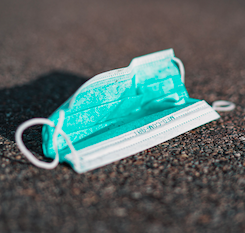The Positive Impacts of COVID-19 on Mental HealthBy: Zahra R.
There has been an increase of awareness with mental health during the COVID-19 pandemic. While it has generally been neglected by society, the Canadian government and companies have put mental health as being a crucial part of lfie during quarantine. Lack of mental health support often causes detrimental effects such as increased stress and suicide. Because of the nature of the pandemic, it was also crucial to determine ways to help each other's mental health with limited physical contact.
While social media may lead you to believe that mental health has been at the lowest points in recent history with increased “anxiety and depression, substance use, loneliness, and domestic violence; and with schools closed, there is a very real possibility of an epidemic of child abuse.” As reported in “The Mental Health Consequences of COVID-19 and Physical Distancing: The Need for Prevention and Early Intervention”,1 there have also been positive impacts on the stigma surrounding mental health, and the treatment of mental health since the pandemic began in 2019.
One example of this is found in “Mapping population mental health concerns related to COVID-19 and the consequences of physical distancing: a Google trends analysis” In this article the authors examined the Google Trends Data from January 1st 2020 to March 30th 2020. They found that while searches that involved suicide markers went up as lockdown protocels increased, so did searches for access to medication and self care practices.2 This indicates that although mental health was negatively impacted by the pandemic, people were actively looking for solutions rather than letting the negative feeling they were experiences to build. The search for self care solutions rather than therapy also indicates that people were aware they needed to look for alternate ways of coping that did not involve contact with others.
Another way that mental health has been positively impacted can be seen on the CDC’s website. They have a webpage titled “Coping with Stress” in which there is a list of ways people’s mental health can be impacted during a pandemic, including a list of helplines one can contact for help and healthy tips on how to cope with your feelings during a pandemic.3 A similar webpage has been created by CAMH which provides resources such as an online chat forum, help for healthcare workers, working through grief, working through anxiety, and coping with quarantine and isolation. The website is even available as an app, so it can come with you to work, the grocery store, or school.4 Even the United Nations’ website now includes a page on mental health, including resources on coping with mental health concerns and free audio files that take the listener through guided meditation or guided yoga, and a resource on how to find external mental healthcare during the pandemic.5
The Washington Post’s article “COVID-19 has shed light on another pandemic of depression, anxiety and grief” found that “the Substance Abuse and Mental Health Services Administration, is issuing 16-month emergency grants to states to provide assistance for mental health and substance abuse disorders during COVID-19”6 and in Ontario specifically (as found on Ontario.ca) twelve million dollars set aside for providing mental health resources. These resources include Internet-based Cognitive Behavioural Therapy, support for healthcare workers and resources for parents with children who do not understand the pandemic or are having trouble coping.7
Overall there has been an increase in mental health awareness. With companies, the government and people reducing the stigma of open discussion of mental health, there has been in increase in alternatives for people to improve theri mental health. Because of the nature of the pandemic, it is also crucial to determine ways to help each other's mental health, while limiting physical contact. Greenberg, Neal et al. "Managing mental health challenges faced by healthcare workers during covid-19 pandemic." BMJ, 2020;368:m1211 Galea, Sandro, Raina M Merchant, and Nicole Lurie. “The Mental Health Consequences of COVID-19 and Physical Distancing: The Need for Prevention and Early Intervention.” JAMA internal medicine 180, no. 6 (April 10, 2020): 817–818. Knipe, Evans. “Mapping Population Mental Health Concerns Related to COVID-19 and the Consequences of Physical Distancing: a Google Trends Analysis.” Wellcome open research 5 (June 10, 2020): 82–82. N/A. "Coping with Stress." Centers for Disease Control and Prevention. (July 1, 2020) https://www.cdc.gov/coronavirus/2019-ncov/daily-life-coping/managing-str... N/A. "Mental Health and the COVID-19 Pandemic." CAMH (accessed November 26, 2020) https://www.camh.ca/en/health-info/mental-health-and-covid-19 N/A "Wellbeing Tips for UN Personell." United Nations (accessed November 22, 2020) www.un.org/en/coronavirus/wellness Marcus, Erin N. "Covid-19 has shed light on another pandemic of depression, anxiety and grief" The Washington Post (November 24, 2020) https://www.washingtonpost.com/opinions/2020/11/24/covid-19-has-shed-lig... N/A "Ontario Expands Virtual Mental Health Services During COVID-19." Ontario.ca (May 5, 2020) https://news.ontario.ca/en/release/56847/ontario-expands-virtual-mental-...
Next Page: Movies and Streaming Services >> |
"Sticky Notes" by Sarah Kilian on Unsplash
"Share Kindness" by Joao Pedro Costa on Unsplash
"Things to do to Avoid the Blues" by Chevron Beckley on Unsplash
"We Will Feel Alive Again" by Alex Bracken on Unsplash
"Yoga with Mask" by Gustavo Fring from Pexels
|

